The use of Kanban in business has grown over time. Originally used for manufacturing processes, businesses continue to adopt it for various operational aspects, including streamlining sales workflows.
This blog will delve into the evolution of Kanban, explore how Kanban-based sales systems can boost team efficiency, and provide a practical example of implementing Kanban within a sales pipeline.
What is Kanban?
Kanban is a versatile method for organizing and managing work, particularly tasks that involve multiple stages or phases. It employs a visual approach using cards and boards to represent work items.
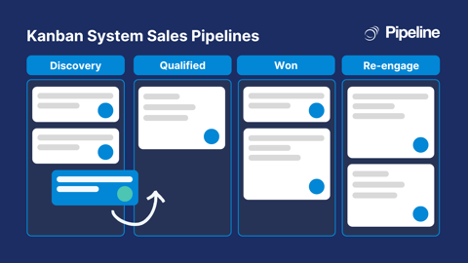
As tasks progress, cards are moved from one column to the next, typically from left to right, signifying their advancement through the workflow. Once a task is completed, its card is moved back to the initial column to start a new cycle or a fresh card is added to begin a new task. This visual representation offers a clear overview of the workflow, progress, and bottlenecks, enabling efficient project management and optimization.
The History of Kanban
The use of Kanban has evolved for different business areas, but the concept stays the same. For what started as a shop signboard, Kanban has transformed into an inventory system, project management system, and more.

Kanban as Shop Signages
In the 1600s, Kanban originated from the Japanese words “Kan” (sign) and “Ban” (board). It was initially used to describe the distinctive signboards that shops in bustling Japanese markets displayed to attract customers. These Kanbans were visually appealing and clearly communicated the shop’s offerings.
Toyota’s Lean Manufacturing Kanban
Toyota, a renowned Japanese automaker, played a pivotal role in extending the application of Kanban beyond its traditional commercial use.
In the 1940s, Toyota faced significant challenges, including poor sales and inefficient manufacturing processes. Taiichi Ohno, an engineer at Toyota, recognized a critical flaw: excessive waste in producing car parts, negatively impacting performance and system throughput.
After visiting an American supermarket, where he observed an efficient card-based system for optimizing inventory, Ohno was inspired to develop a similar approach for Toyota’s manufacturing process. This system, later named Kanban, utilized cards to signal the need for specific products, or the right time to re-manufacture specific car types.
By implementing Kanban, Toyota achieved several benefits: reduced stockpiles, improved workflow efficiency, and enhanced visibility into the production process. The success of Kanban within Toyota paved the way for its integration into the Toyota Production System, a manufacturing philosophy that has become a benchmark for lean practices worldwide.
Kanban in Today’s Business
Kanban has found widespread application in various business and industrial sectors. One prominent example is its influence on Scrum, a popular agile development framework. Another significant application of Kanban is in project management systems, where each task to complete the project is assigned to a card, and as the tasks are completed, they’re moved to the finished stage.
Leveraging Kanban Sales System for Effective Sales Workflows
Recognizing Kanban’s versatility and benefits, many sales teams have successfully adopted this methodology to manage their sales pipelines. The core concept remains consistent: each lead or opportunity is represented by a card that moves through various stages of the sales pipeline, from initial prospect to final outcome (such as deal won, lost, or reengage).
This visual representation of Kanban provides a clear overview of the sales process, offering many sales teams the following benefits:
- Clear visibility of sales pipeline: a Kanban board provides a clear visual representation of the sales pipeline, allowing sales reps to track deals at different stages.
- Improved prioritization: by limiting the number of deals in each stage, sales reps can focus on the most important opportunities and avoid getting overwhelmed.
- Enhanced focus: Kanban helps sales reps prioritize tasks and avoid multitasking, leading to increased focus and productivity.
- Faster deal closure: by identifying bottlenecks and streamlining the sales process, Kanban can help sales teams close deals more quickly.
- Better collaboration: Kanban boards can be used to foster collaboration among sales team members, ensuring that everyone is aligned and working towards a common goal.
- Data-driven insights: by tracking key metrics like cycle time and conversion rates, sales teams can gain valuable insights into their performance and identify areas for improvement.
Examples of a Kanban Sales Process in Pipeline CRM
The benefits of adopting the Kanban sales system are a no-brainer, but how can you apply that to your existing sales workflows? Let us show you by looking at Pipeline CRM’s Kanban sales board.
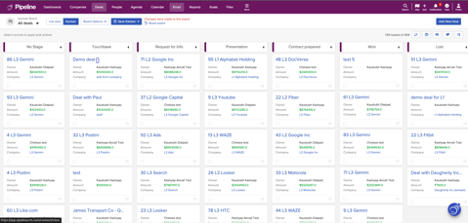
Deal Organization
As you can see from the screenshot above, the deals (cards) are organized across different sales stages (columns). These sales stages are sequentially arranged from left to right, mirroring the progression of a deal from initial contact to its final outcome. This visual representation facilitates the tracking of deal movement and provides a clear overview of the sales pipeline.
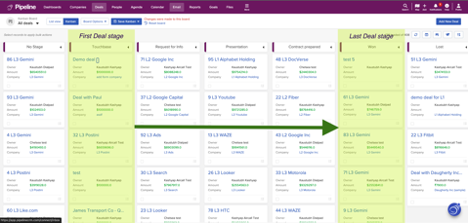
Deal Progression and View Customization
To advance a deal to the next stage, simply drag and drop the corresponding card to the desired stage column. The deal status on each card will be automatically updated to reflect its new position in the pipeline. You can add, edit, or delete sales stages to align with your team’s specific terminology and workflow.
A typical deal flow might include stages such as ‘No Stage > Touchbase > Request for Info > Presentation > Contract Prepared > Won > Lost > or Reengage.’
To further customize the deal cards, you can specify the key information displayed on each card. This enables you to access essential details about each deal quickly. For more advanced analysis, you can filter and sort cards based on various criteria, such as sales rep, deal value, or stage. This helps you prioritize tasks, identify opportunities, and gain valuable insights into your sales pipeline performance.
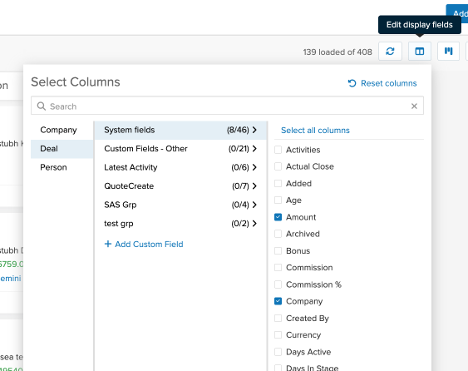
Moreover, Pipeline CRM’s sales Kanban offers a unique feature that allows you to collapse certain deal stages to maintain a concise view, especially when dealing with lengthy sales pipelines.
By simply clicking on a deal stage name, you can temporarily hide it, reducing visual clutter and focusing on the most relevant stages. To expand the collapsed stage and view its associated deals, simply click on the collapsed stage name again.
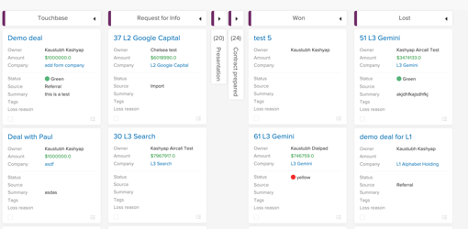
Find out more about what Pipeline CRM’s Kanban sales system can do for you and the available customization options.
Get a Clear View of Your Sales with Kanban Pipelines
If you find the traditional spreadsheet view insufficient for managing your sales pipeline, a Kanban-style approach can offer a more visual and intuitive solution. By providing a clear overview of your sales pipeline, you can easily monitor the status of each deal, track the performance of individual sales reps, and gain a comprehensive understanding of your overall sales performance.
Interested to try it out? Sign up to Pipeline CRM today for a 14-day free trial!



